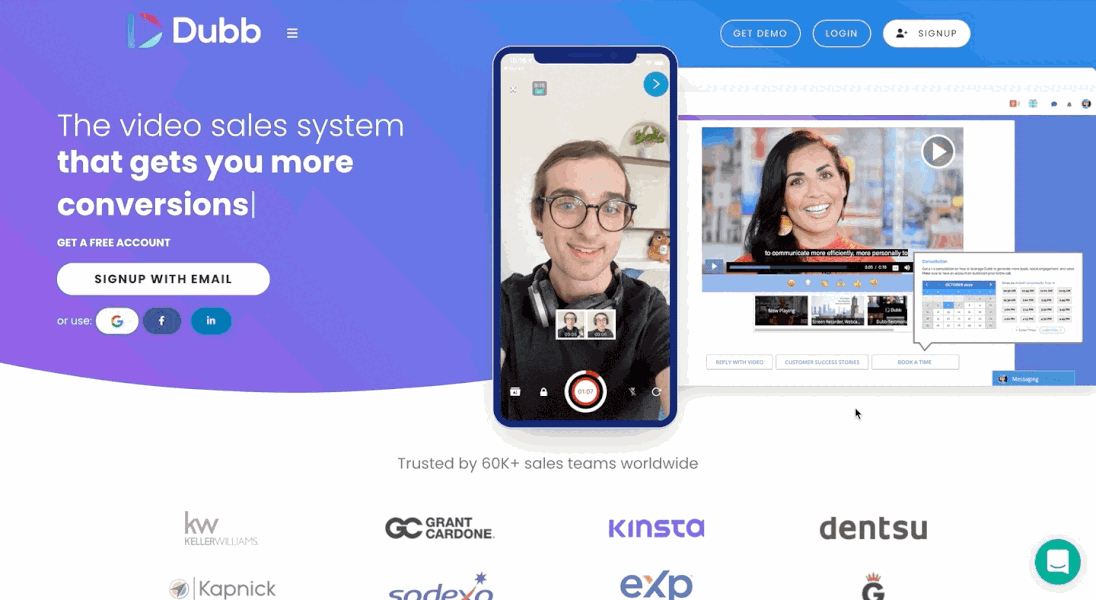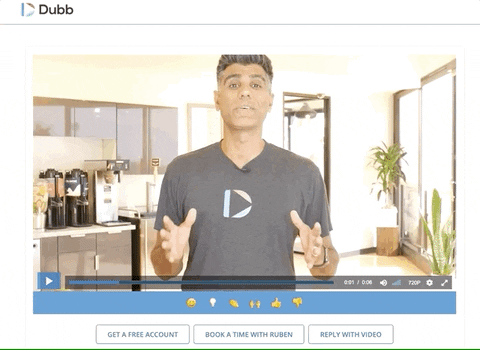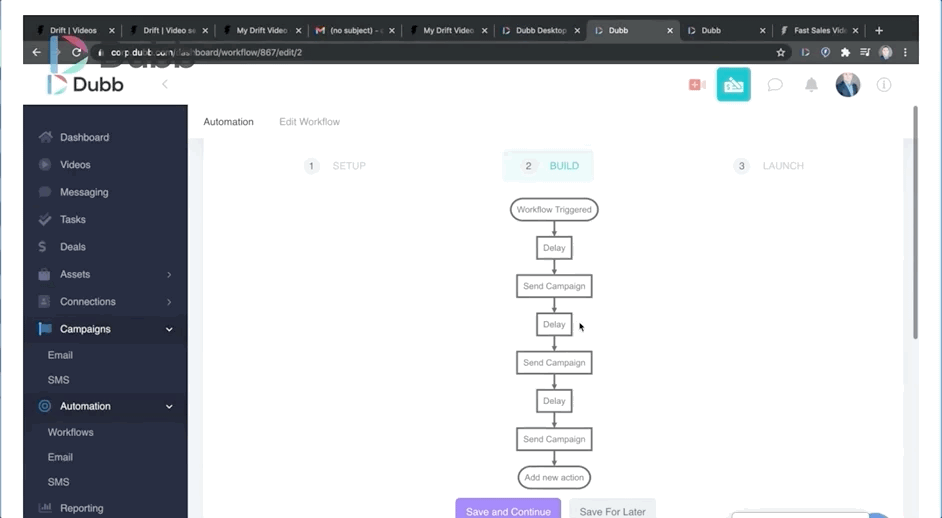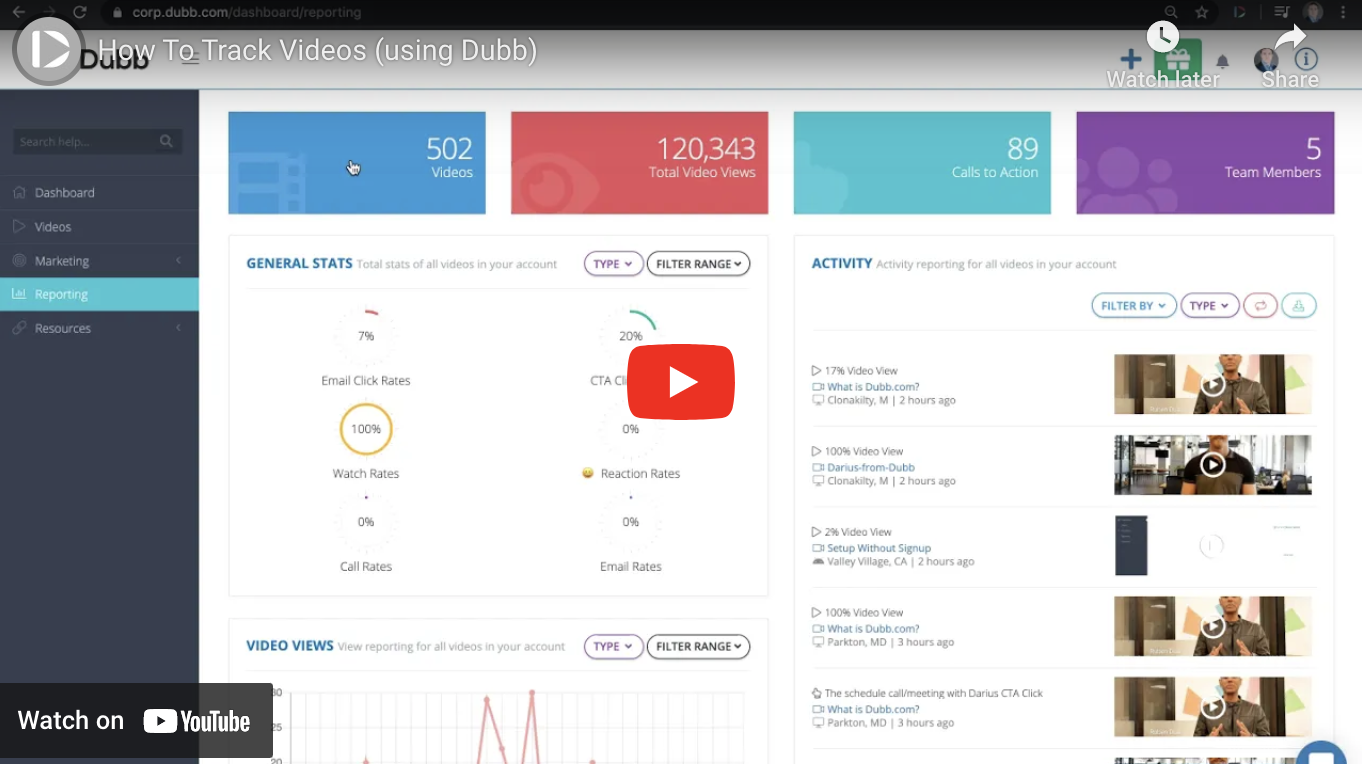In this recap post from a Dubb Support video, we are going to discuss how to track videos using Dubb. Dubb is a fantastic tool that you can use to track your sales and marketing videos, thereby giving you the data to deliver more value to your audience and generate more sales. If you would like to view the video in its entirety, go ahead and click on the link above. Enjoy!
Have you been wondering how to track videos that your sales or marketing departments have created? Along with this, have you been curious about ways that you can use this tracked data to create more relevant content for your audiences and generate more sales?
If so, you are definitely in the right place. Tracking your sales and marketing videos is an extremely valuable exercise. Whether you are trying to gauge interest in a new product or service or simply want to learn more about a specific prospect’s interests and goals, you can do so by using Dubb. Dubb’s platform makes it extremely easy to create video content, see how your audience is interacting with that video content, and generate more sales.
So are you ready? Let’s take a deep dive into how to track videos using Dubb. By implementing the insights and lessons in this post, you will be able to take your sales and marketing videos to the next level.

Why You Want to Track Your Videos
Before getting into how to track videos using Dubb, I think it is important to take a step back. Knowing the immense value that you can get from tracking your videos is a key component of this overall discussion. After all, if you’re not sure about why you are tracking your videos in the first place, chances are that you won’t get the most out of your analytical work. It will be easier to just ignore the data and focus on something else instead of using the data that you have in many accretive ways.
Simply put, tracking your videos provides you and your organization with a wealth of data. Data in and of itself, however, isn’t valuable. It is what you do with that data that makes tracking your videos so important. And rest assured: there are plenty of things you can do with that data, whether you started a young startup or work for a much larger organization.
If I had to sum it up, I would argue that tracking your videos lets you build stronger relationships with your audience. In the sales and marketing context, stronger relationships lead to more sales. It is as simple as that. Whether you are getting to know a prospect at a conference or are working to close a sale at a high-stakes dinner, relationships are the things that are going to help you reach your sales and marketing goals. It’s also true if you are selling a low volume, high ticket item or a higher volume, low ticket item.
So how can tracking your videos help you create stronger relationships? Essentially, the data that you receive from your video content can give you a granular look at what your audience is doing. We’ll get into this shortly, but using a tool like Dubb, you can see things like whether a specific audience member watched the entirety of a specific video. This type of data is priceless. It can help you get some key insights on whether a certain prospect is interested in a particular topic, whether it is your product or service, an issue that is affecting your industry, or something else. Then, with that data, you can have more effective conversations with that prospect. You can add value, and by doing this, you strengthen the relationship.
An example is helpful here. Let’s say that you are in the business of coaching other entrepreneurs. You work with soon-to-be and current entrepreneurs as they work to launch, grow, and scale their businesses. As part of your coaching business, you create all different types of content (including video content). You may be targeting a specific prospect that you believe would be well served with your consulting work. Consequently, you may decide to send that prospect a personalized sales video and a lengthier video about your services. Using a tool like Dubb, you can send both videos to that prospect and see how the prospect reacts to those videos. You can see not only if the prospect watched either (or both) videos, but you can see if she interacted with any of your links. With that knowledge, you can advance the relationship. If you notice that the prospect dropped off at a certain part of your longer services video, for instance, you can avoid discussing that topic in your next video or sales meeting. By contrast, if you saw that the prospect repeatedly watched a specific part of that sales video, you can further probe that topic or idea. Essentially, what you are doing here is taking the information that your viewer gives you and using it to build a stronger, more personalized relationship.
Don’t forget: stronger relationships lead to more sales. It is for this reason that analyzing the data that your audience provides you is so valuable. It can help you create more relevant and targeted video content throughout your entire sales pipeline. While sales and marketing professionals like you are always working to build stronger relationships, your work can be easier and more systematic by using data from your videos.
An Overview of Some Basic Tracking
With that background in mind, I now want to talk about some basic tracking. Starting with the basics here, you can get a much better idea of how video tracking can help you build those strong relationships and generate more sales.
There are plenty of different metrics that you can use to track your viewers’ behavior. One of the more basic metrics that you can track is the number of videos that are watched. If you go to YouTube, for instance, you can actually see this data as a viewer. You can go to a specific video from one of your favorite YouTubers and find out how many people watched that video. The number of views is a helpful metric. It may be a more crude metric than some of the others that we discuss in this post, yet it can give you a general sense of what your audience is interested in.
At the same time, there is a shortfall here. YouTube analytics can only take you so far (both as a creator and a viewer). Yes, you can see the number of views of your specific videos. That said, you are leaving a significant amount of value on the table here (especially if you are creating sales or marketing videos). Using a tool like Dubb, you can get much more detailed analytics. By using Dubb, you can see who is watching a specific video, what percentage of the video they have watched, if they clicked on any specific links, and more. Basically, you get the who, what, where, and when by uploading your videos to Dubb. Simply put, you don’t get this type of data on a service like YouTube. While YouTube offers scale, it won’t give you the data that you need to accomplish your sales and marketing goals.
How to Track Videos Using Dubb: One-to-One Videos
The great news? It is extremely easy to get all of this granular data on Dubb. By becoming a Dubb user, you can see how certain prospects are reacting to certain videos that you create. Moreover, you can even see if any of those prospects clicked on any call to action buttons. At Dubb, we recognize that these features are extremely powerful, so we are constantly working to make them even more helpful for our users.

At this point, the natural question is how to get started with Dubb. And if you are already a Dubb user, how can you get the most out of the reporting and tracking data that you already have?
If you haven’t done so already, you will need to sign up for a Dubb account. You can do so by clicking here. If you are a new user, you can take advantage of a free 14-day trial of our premium plans, so don’t hesitate to do so. If you already have a Dubb account, feel free to go to dubb.com and log in to your account.
From there, you will need to have a video to analyze. You have several choices here. For instance, you can take a video that you have already recorded and upload that video to Dubb. If you don’t already have a video, however, you can create one by using Dubb. You can shoot your video on your Mac or PC. Alternatively, you can download the Dubb mobile app (which you can find for both iOS and Android by clicking here) and shoot some type of video from your smartphone. The Dubb mobile app is great for recording selfie videos or other video content when you are away from your office. Once you are done recording and editing your video through the Dubb mobile app, your video automatically gets uploaded to the Dubb platform.
Now, once you have uploaded your video to Dubb, you are going to want someone to watch your video. This is the exciting part. Here, we are going to assume that you send your sales video to a specific prospect. In other words, what we are doing here is analyzing a one-to-one sales video. There may be instances where you want to send your sales and marketing videos to more than one prospect. We will discuss that later in this post, so stay tuned.
Now that we know that we are going to send our sales video to one individual, you will want to go to your Dubb homepage. From there, you can click on the “Videos” tab to see a collection of videos that you have already created through Dubb or uploaded to Dubb. At this point, you’ll want to click on the video that you want to send to that individual prospect.
There are several different ways that you can share your video. For starters, you can click on the “Share & Send” button. Then, you can click on the “Copy for Email” button and send the video through your Gmail, Outlook, or any other email client. One of the cool things about doing this is that upon inserting your video into the email, Dubb will automatically generate a three-second animated GIF. This GIF is a great way to entice your prospect to click on the video and start watching.
Before clicking on that “Copy for Email” button, however, you will want to look above the button and add the viewer’s email address to your database. If the contact is already in your database, you should see their name and email address appear. If not, you will need to do that yourself. You can also send your videos this way through an SMS message. No matter how you want to communicate with your audience, Dubb makes it easy to get your video in front of them.
Once people start watching your video, the tracking starts to take place. For instance, let’s assume that the prospect you targeted received your video. Once she opens the video (whether it is on her desktop or smartphone), you will receive a notification. That notification will let you know that the prospect opened the video, what percentage of the video the prospect watched, whether she clicked on any links, and more. You can enable or disable these real-time notifications on your desktop and/or cell phone. To get those notifications on your cell phone, however, you will need to download the Dubb mobile app. Sometimes, real-time notifications can be distracting. However, if you want to receive up-to-the-minute updates from Dubb, you can certainly do so. The choice is yours.
Notifications are helpful if you want to stay up to date while you are working on other tasks throughout the day. If you are within the Dubb platform, however, you can also easily find this tracking data. It exists in several places.
For starters, you can find some data within the Dubb Chrome extension (if you haven’t yet downloaded it, you can do so by clicking here). You can also find reporting on the website itself. If you go to your Dubb page, for instance, you can see a “Reporting” tab. By clicking on that, you will see that you have a wealth of data at your fingertips. There is a general reporting area that shows metrics like your email click rates, call to action click rates, watch rates, call rates, and more. On the right side is an activity panel. You are able to filter your activity reporting based on things like call to action clicks, page views, and whether a viewer has sent a video reply to your initial video. Dubb also gives you the freedom to download this report (it returns a CSV file). This can be really helpful if you want to go even further and filter your data in a tool like Excel.
How to Track Videos Using Dubb: One-to-Many Videos
We just spoke about how you can get data from one-to-one sales and marketing videos. While the exact proportion may vary depending on the size of your business and your specific goals, you will probably be sending quite a few one-to-one videos. However, what happens if you want to send a specific sales video to groups of people? Using Dubb, it is easy to both send the video and track the data from that video.
But let’s back up. If you are using a third-party email tool (like MailChimp) or a CRM tool, you can get some basic tracking analytics. The tool that you are using will probably be able to show you who opened your email and if links were clicked. However, if you are sending a Dubb video through a third-party tool, you will only be able to see how many times the video was watched, what percentage was watched, and if links were clicked. Unfortunately, you wouldn’t be able to see who is watching and clicking on the video.
If you want to send one video to a list of people and want more granular information, you can use Dubb’s in-house email sending tools. To better illustrate this, I want to talk about a campaign that we sent to around 11,000 people. Assuming that you sent a similar campaign, you would need to go to your Dubb dashboard. From there, navigate to the left side of the screen and click on “Marketing,” then “Campaigns,” and then “Email.” Under the “Actions” tab, you can click on the “View” button to get to a page that contains plenty of information about the campaign. On that page, you can see different types of analytics (including email rates, click rates, and more). You can also filter that data even further to see exactly who clicked on what, what video a particular prospect watched, what percentage of that video they watched, and more. All of that detailed information is right at your fingertips.
And as a reminder, you can download all of that data as a CSV file. This CSV file can be extremely useful as you are gauging the success of your one-to-many sales and marketing videos. Don’t hesitate to take advantage of this feature.
Sending Videos Through Automations
To this point, we have talked about gathering data on your one-to-one and one-to-many videos. These are the two main types of videos that you can send to your prospects, customers, and fans. At the same time, you can also make your life easier by automatically sending those one-to-one and one-to-many videos. The great news is that if you are using automations on Dubb, you also get access to the granular data that we discussed above.
To start, you will need to go back to your Dubb dashboard. You will then want to navigate to the left side and click on “Automation” and then “Workflows.” Like above, you will want to go to the right side (under the “Actions” column) and click on the blue icon with a pencil. This lets you edit an already-existing automation. If you haven’t yet created an automation, you can do that by clicking on the “+ New” button on the top right of the “Automations” page.
Once you have created your workflow, you can be sure that every step of your workflow will be tracked. If anyone is enrolled in one of your Dubb automations, you will be able to gather some granular data about how they are interacting with the workflow. Some examples are that you’ll be able to see whether they opened emails, if they clicked on links, the specific percentage of a video watched, and more. This is true from the moment they enter your automation workflow to the moment that they become paying customers.
There is an important caveat here, however. If you are using Dubb in a third-party automation (like Infusionsoft or something similar), you won’t be able to specifically see who is watching specific videos in your automations. All you will be able to see are general statistics about how your videos are performing. You don’t get these limitations when you are automatically sending your Dubb videos on the Dubb platform. Whatever path you choose, make sure that you keep this in mind as you are creating content and leveraging automations.

A Brief Note on Testing
Finally, there is one additional thing to consider in this discussion of how to track videos using Dubb. People often try to send videos to themselves to confirm that their videos are being tracked. This can be a good idea (especially if you are tracking your videos for the first time).
You can do this; however, at Dubb, we have an exclusion built-in that will exclude your own IP address from tracking. Therefore, if you want to send a video to yourself to see how the tracking works, you will need to take a few steps. For instance, if you created a video and sent it from your laptop, you can then open the video on your cell phone to test the tracking. Before doing so, however, you will want to make sure that you connect to a different Internet source. As an example, if your laptop is connected to your office Wi-Fi, make sure that you are connected to a mobile Internet source or any other type of different Internet source. Then, open the email. This will allow the tracking to kick in.
Ultimately, you don’t want to be in a position where you think you are tracking your videos but you actually aren’t. To avoid this situation from the start, feel free to test your tracking. Once you know that your tracking is working, you can then send your sales and marketing videos with complete peace of mind.
Going Forward and Tracking Your Videos
We started this blog post by raising the question of how to track videos using Dubb. To answer this overarching question, we explored ideas like why tracking is so important, why you can get some tracking data from major platforms like YouTube and MailChimp, and why Dubb offers plenty of features to help you get the most out of your tracking and analytics work.
As you can see, by using Dubb, you can get some really granular details about particular members of your audience. Whether you are looking to hit a yearly sales goal or simply want to learn more about how to convert a specific prospect, I recommend that you take advantage of these tracking features. They will go a long way in making your life easier and increasing your conversion rate.
In the end, however, make sure that you remember why you are tracking this behavior. The overall goal isn’t to gather as much granular data as possible. It is to use the data presented to you to build the strongest relationships with your prospects, customers, and audience members. By focusing on adding value and building strong connections, you will be well on your way to hitting your sales and marketing goals. So make sure that you remain consistent and keep this higher idea in mind. Your future self is already thanking you.
At Dubb, we love talking about topics like how to track videos. If you have any questions about this topic or would like to learn more, I encourage you to contact our team. You can also click here to learn more about Dubb and click here for a free 14-day trial of our premium plans.


